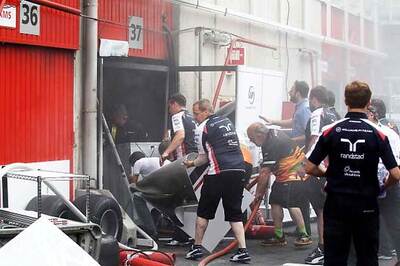
views
Harshit (Rathore) and I have known each other since college and have worked on various projects together. Both of us are passionate about cars and electromechanical systems and spent most of our time in college making full-scale, off-road cars for IIT-Kanpur motorsports. It was during internship when we got a first-hand exposure to the corporate world and realized there were ample opportunities in the hardware sector in India. We decided to start Noccarc after returning to college, and worked on various products. Both Harshit and I always felt that we, in India, lack in highly sophisticated products and wanted to fill this gap, which actually pushed us to pursue entrepreneurship.
During our market research, we found that solar installations were growing at a fast pace and there were multiple opportunities for startups in it. We started working on solar panel cleaning robots after starting Noccarc formally in 2017. Just after eight months of incorporation, we became the first Indian company to commercialize the robotic cleaning solution in the market. After successful acceptance of the product, we raised investment from an IAN (Indian Angel Network) fund to scale up the R&D and manufacturing facility. We set up a new facility in Pune in 2019 and started working on establishing the supply chain to cater to large orders. Several pilots were in the works; we were in the final stages of closing some deals in March 2020 when we had a lockdown. The entire business came to a halt due to restrictions on travel and the factory was closed. We had nothing to do but keep our eyes open for a new opportunity as advised by our guru, Dr Saurabh Srivastava (former chairman of NASSCOM).
Among all the problem statements at that time, ventilator was among the most complex besides vaccine. We had already worked on the complex robotics systems and Noccarc team had the expertise required to develop the highly sophisticated device. After brainstorming on the design and concepts for three days, we had the confidence that we can build the product and, therefore, decided to take up the challenge. It took us 90 days and support from SIIC (startup incubator at IIT-K), 20 mentors (industry experts) and state and central government agencies. This collaborative effort towards a common goal finally resulted in an affordable, high-end ICU ventilator. The 90-day journey has also been chronicled in the book, The Ventilator Project.
Design and Innovate in India
India has been dependent on imports in various sectors, like healthcare, energy, diagnostics, etc. because of unavailability of latest technologies. Most complex electromechanical devices are either imported or designed outside India. This not only increases the cost of the product for the end-customer but it also faces a risk of supply chain disruption in situations like a pandemic. During Covid-19, various global companies shifted their supplies to home country and delayed even the ongoing orders from India. India needs thousands of innovations to make us self-reliant.
ALSO READ| The Pandemic is a Tipping Point for Govt’s Role as Strong Facilitator, Transparent Regulator
Make in India will not be a self-sufficient enterprise without ‘design and innovate in India’ as the latter affects the affordability of the product. With a population of 1.38 billion, India itself is a large market for any product which is developed and manufactured in India. Having the best engineering minds in the world, India has the potential to emerge as a global innovation hub. We have seen world-class innovation happening in the software industry and the same needs to be replicated in the hardware space too. Companies like Ather Energy and GreyOrange are examples of how we can lead in hardware sector.
With a significant focus and structured approach of the government towards startups and innovations, entrepreneurship has been turned into one of the best options for any individual in this country. Setting up incubation centres—Atal incubation centers and those in colleges—is not only encouraging students to take up entrepreneurship as a career choice but has also increased the success rate of these startups. Government has launched enormous schemes to fund these projects and support them in various ways possible, which allows them to overcome the challenges during the initial days of starting out. Schemes like the SASACT (Scheme for Accelerating Startups Around Post COVID Technology Opportunities), NIDHI (National Initiative for Developing and Harnessing Innovations), Biotechnology Ignition Grant (BIRAC) are easily available to any innovator in the country to turn their product into a reality.
Incubation centers like the SIIC have stretched themselves and with the help of IIT Kanpur and its alumni have made entrepreneurship risk-free. Similar models, if replicated in other incubation centers, will change the landscape completely as most innovations will be driven by startups that are thirsty for growth and are fast and agile.
Streamline Standards and Certifications
This is a great time for entrepreneurs as the startup ecosystem is flourishing and the push from the government has increased manifold. Entrepreneurship is now a profession which is celebrated and supported by peers and family which makes it easy for the founders to survive tough situations. The investment scenario has also changed now, and various angel and venture capital funds are available for pre-revenue and post-revenue startups.
ALSO READ| What’s Common to England Lifting 2019 World Cup, Imtiaz Ali Movie and IIT Kanpur’s Ventilator Project?
To capture this opportunity, few changes and initiatives are needed, which should be taken by the government and industry chambers. One of the most important interventions needed is in the area of quality standards and certifications. Products designed in India are seen as sub-par even in India—this is especially true for the healthcare industry where majority of the market is dominated by imported products. We need standards of international quality and an infrastructure to get the products tested. Currently, various products designed in India have to go through both Indian and international certification process, which is not only time-consuming but is sometimes not feasible for startups with low-cash budget. Industries need to come forward and set their own standards of manufacturing collectively so as to build a global ‘Made in India’ brand.
For any industry to flourish, vendor base plays a key role. Companies largely depend on imports for key components for complex devices. A support to develop key components and awareness around the same should also be the focus to make ‘Make in India’ a success.
Read all the Latest News, Breaking News and Coronavirus News here




















Comments
0 comment